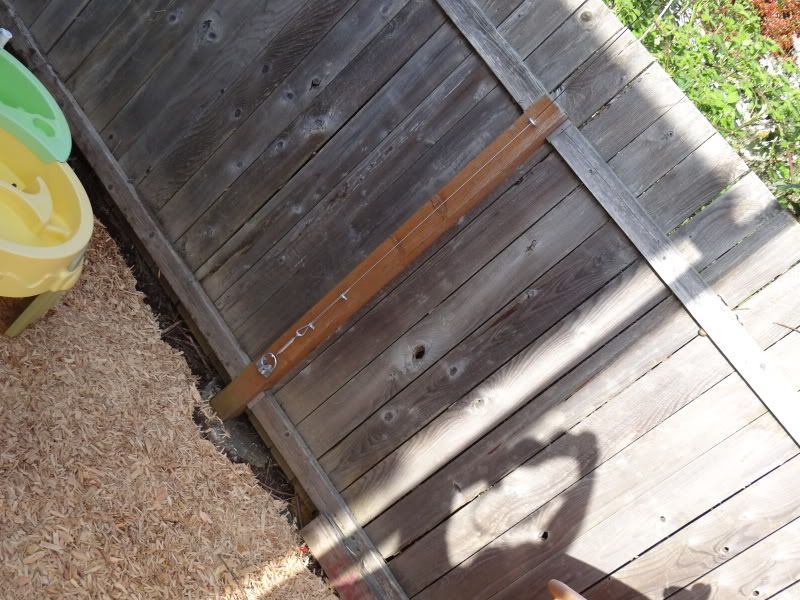Last year I grew a single lowly hop plant, Chinook, and collected a whole 21 cones. First year, potted, lacking knowledge concerning nutrient deficiencies, all of these culminated in a weak first year. But now we enter a new season, new plants, new knowledge, new trellis system. Last weekend I cleared out the entirety of our backyard from all forms of plant life. We dug down the whole thing a good 3 - 5 inches. We brought in Playground Chips and laid it on thick over landscaping fabric... except for one strip of land about 2 foot wide by 24 foot long. It was here, along the back wall, in full exposure to the sun that I erected the hop trellis. On each end, I dug a hole 20" deep by about a foot wide into which I dropped a 14' 4X4 treated post cemented into a 2 gallon bucket. The cement helps to make it slightly more permanent as well as add weight for an anchor, and putting it in the bucket allows me to dig it up and move it if/when we buy a house. At the top I threaded an eye-bolt screw to attach my wiring. I ran a length of 3mm Aircraft Cable from one eye-bolt, through a hole in the top of a 2X4 sunk into the ground between the posts for mid-way support, and through the other eye-bolt, down the post to a third eye-bolt where I attached it via a turnbuckle. From the same eye-bolts at the top, I ran more cable to the fence posts where it went through an eye-bolt at the top of the post down to a ring attached to the bottom where it connected via another turnbuckle. These guy wires pull the posts outward to anchor them so they don't collapse in towards each other under the weight of the hop plants. They also pull them back some since the posts are 5 feet from the back fence and the fence posts are 8 feet. This pulls the posts against the overhang of the house, thus anchoring the post in all four directions. They can't fall back because the house is there, they can't fall out because they are anchored to one another, and they can't fall forward or in because of the anchors to the fence. The space provided allows me to plant 7 hops in between the posts, and an extra 2, 1 at each fence anchor to grow up the anchor wires and along the fence, giving me room for 9 varieties. I then back filled the holes to ensure stability.
Next I dug out the top 3 inches of soil across the top of the entire area and added about an inch and a half of fresh planting soil from Lane Forest Products. I also took a pic-axe (wish I would have used this to dig the post holes) and used it to dig holes about every 3 feet that were about 3" wide, 8" long, and 6-8" deep which I filled with the same new soil and piled up on top to make mounds about 3 inches high ( giving a final depth of about a foot). On top of this I added an inch and a half layer of bark mulch for ground cover, to keep weeds out, and to keep nutrients like Nitrogen in (something I didn't do last year). I transplanted my Chinook from the Rubbermaid I used last year and put it to the outside edge of the trellis. I underestimated the depth and size of the roots that these things put out. I thought it would have some roots around it being a year old, but they went all the way through the 25 gallon Rubbermaid and even out the hole in the bottom. I also bought a healthy rhizome from Falling Sky of Brewers Gold (mother variety to many of the high alpha American hops, with decent bittering [~10%], and aroma/flavor of spice, fruit, resin, and Black Currants). The rhizome was shaped like a boomerang with shoots on the top of one end and coming from the bottom on the other with flip-flopped roots as well, so I cut it in half and planted them each roots down, shoots up, facing opposite ways in the same hill, and covered with soil and mulch.
I will be adding quite a few more varieties (see here for more info on these hops) along with these two, such as, commercial American varieties Cascade, Centennial, and Santiam, old-school New Zealand variety AplhAroma, French Tardif d' Bourgnone (Strisselspalt and Saaz like), as well as 2 experimental varietals: American high alpha, high aroma Blisk and the Continental / Saazer type variety Cerara. There is also a Japanese variety called Shinsuwase with a very perfumey nose that I might try to plant as well (at the loss of another variety). I will of course continue to update the progress of the hop yard with lots of pictures and hopefully some helpful hints on how to maintain, feed mid season, trouble shoot, harvesting and drying the hops, as well as experimenting with each variety in SmAsH beers to evaluate there contributions.




No comments:
Post a Comment